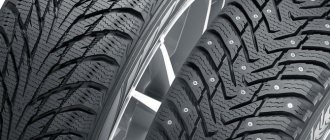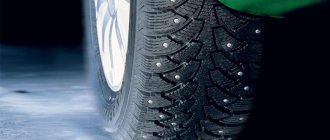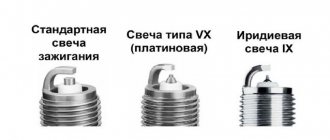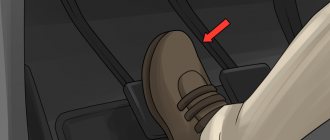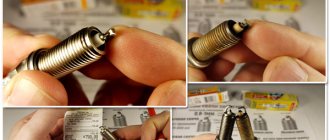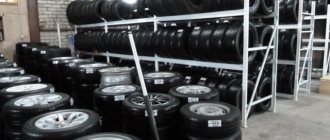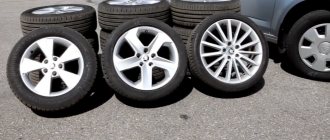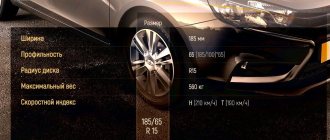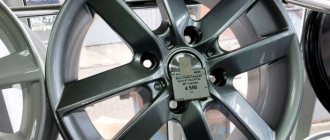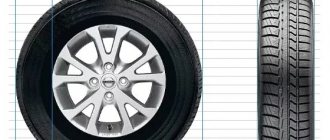Running in studded tires is a mandatory procedure that involves using the tire in a gentle mode to get used to the dynamics of acceleration/braking and for the studs to settle into place.
During break-in, it is prohibited to make sudden maneuvers and drive at speeds exceeding 60 km/h.
Below we outline the rules for running-in for tires of different models and provide recommendations for performing such work.
Let's figure out the reasons for the premature loss of studs, talk about the technology of making studded tires,
Causes of early loss of spines
During operation, drivers often encounter a situation where the studs fall out ahead of schedule, namely after one or two seasons.
There may be several reasons for this:
- Moving at increased speed. Leads to a greater load on the tenon with subsequent heating of the seating area and a decrease in the effectiveness of the adhesive in the socket.
- Sharp acceleration and braking. Active driving mode leads to loosening of the product in the socket, which is why it quickly jumps out of the recess.
- Incorrect tire pressure. A decrease in tire pressure below normal leads to an increase in the contact patch with the road. This leads to overheating of the tire, increased friction and premature falling out of the studs. Excessive inflation of the tire causes the central part of the projector to bulge, causing the spikes to come into closer contact with the surface and wear off.
- Frequent slippage. When the wheel rotates in one place, the spikes may not withstand the load upon contact with the road and fly out.
- Wear. During use, rubber loses quality, becomes stiffer and less elastic. Over time, damage appears, including at the nest site. The depression increases in diameter and the thorn falls out.
And to understand why running in studded tires is necessary, you need to know the principles of its manufacture. We will dwell on this issue in more detail below.
What is it for?
So, why do you need to break in winter studded tires? First of all, this is necessary for the driver. Do not forget that with such tires the vehicle will behave differently than with summer tires. The driver just needs some time to get used to it. However, this is only one of the reasons.
The studs on the rubber should find their place. Otherwise, they can be quickly lost. After all, if such rubber is used incorrectly, the studs can easily fly out. In addition, you can damage your tires. Running in winter studded tires will allow you to place the studs in their grooves. As a result, grip will improve, the vehicle will listen to the driver and the new tires will last more than 4 seasons.
Production technology of modern studded tires
Studring is a process that is carried out by the manufacturer with strict adherence to the number and quality of studs. These parameters are set by EU governments and all tire models must meet the requirements.
To attract buyers, manufacturers are trying to insert more studs into tires, using different technologies and placement patterns.
The work of installing studs is often carried out not in the country of the tire manufacturer, but at other factories located in the Russian Federation, China and other countries. This is done to reduce manufacturing costs and simplify delivery.
For example, the Pirelli and Michelin companies send tires for stud installation to Voronezh and Davydovo with subsequent transportation to one or another country.
Interestingly, the studs used for studding are not made by tire manufacturers, but by other factories.
The most popular manufacturers include Tikka, Turvanasta and Scason (Finland), Ugigrip (France) and Tecom (Russia).
Tecom - 12-8-2TR
Automatic tucking
The introduction of spikes can be fully automated with computer control. The latter, using sensors, determines the installation location and implements the product in a certain place.
After installing the tenon, its protrusion and indentation force are checked. To simplify the process, a special lubricating soap composition is used.
The technology described above is typical for most modern companies, but the manufacturer Continental has gone even further and uses a more serious technology in which the spike is “soldered” into the surface.
The algorithm of actions is as follows:
- Treating the spike with a thermoadhesive compound.
- Studring a tire blank (just called a blank).
- Vulcanization to give the correct shape and desired pattern.
- “Soldering” the stud and rubber to form a tight connection.
The use of this technology increases the reliability of the tenon fixation. To pull it out, it is necessary to apply a force of about 500 N*m, and this is an order of magnitude higher than during the usual studding process. Other companies have not yet been able to improve this parameter.
Hand tucking
Here the spikes are inserted by a human rather than a computer, which requires special attention from the performer. The products are inserted into the prepared recesses using a tool.
So why do you need a break-in?
The fact is that the studs are inserted into the already welded tire by pressing it into the prepared holes (with the exception of some Continental models).
After studding, the tire must rest for 24 hours at a temperature of 20-25 0C and during this time the rubber flows into all the cracks, thus securing the stud.
But the fact is that even a perfectly tuned stud machine has its own tolerances for the protrusion of the stud above the tread surface, as a rule, this is 0.5 mm.
For this reason, some tenons will sit deep in the grooves, while others will not. And it is the running that will allow the studs to take their place in the tire, protruding to the same height.
Taking into account the above, there are several reasons why running in new studded tires is necessary:
- Establishing the correct position of the studs in the tire tread.
- Adaptation of driving style to new winter tires with individual characteristics.
- Removing excess debris and fluid residues that may have remained under the wheel studs.
All these measures will allow studded tires to last for two or more seasons with minimal loss of metal elements. There are cases when such tires have been maintained for 5 seasons.
How to properly break in winter tires
During break-in, driving style restrictions must be observed. The speed should be increased gradually, starting with a limit of 60 km/h, raising it to 80 after the first hundred kilometers. You should not be overly careful with this process, at least when it comes to Velcro.
The above-mentioned foreign substances from the slots and the surface layer cannot simply be removed, so you will have to accelerate, brake and corner relatively dynamically. But, of course, not at the maximum capabilities of the car, this is still a run-in.
Run-in according to the indicator
It was noted above that before starting the break-in, it is necessary to record the odometer readings. If you did not have time or forgot to do this, use the indicator readings.
Any new tire has an indicator notch (corrugation) near the metal insert.
After the indicator has been rubbed off on the asphalt, it is considered that the running-in of the new tire is complete and you can use it as usual.
Indicator monitoring requires periodic inspection of the tread, which becomes dirty during operation and requires cleaning from foreign objects.
The inspection can be carried out in parallel with checking the tire pressure level.
Some manufacturers use mini-grooves (Bridgestone) or special stickers (Nokian).
In each case, we can talk about the completion of the run-in based on the abrasion of the indicators.
An additional indicator is the lubricant that is applied to a new winter tire.
Before the lubricant evaporates, it is necessary to move smoothly and not exceed the maximum speed.
Summarize
Running in is a mandatory event that can ensure proper operation of new winter tires, additional safety on the road and reduce the likelihood of accidents. It is carried out regardless of the manufacturer and model of tires, class and drive of the car. The driver gets used to the behavior of the new tires and changes in the habits of the “iron horse,” which can be significant.
You should not overly rely on extensive driving experience and a huge number of kilometers traveled on winter roads. Caution, attentiveness and gradual adaptation to new tires are components of accident-free driving in the cold season.
Source
Which road is better to run in?
Compliance with the correct operating mode does not guarantee high-quality running-in. The success of the event depends on the correct choice of route.
To avoid problems, follow these tips:
- Run-in is carried out on a flat asphalt road at a temperature of zero to ten degrees Celsius.
- Avoid driving on country roads or dirt roads.
- Run on flat surfaces without holes or potholes to avoid damage to the studs.
- Park on level areas without adjacent to or driving over curbs.
The conditions considered are available not only in big cities, but also in small towns.
To extend the life of winter tires with studs, try to run them under the conditions stated above.
Dangerous grease
If you touch new tires, you can feel a slippery coating - this is factory lubricant. This compound clogs all the slots and grooves in the tread of new rubber. It's not very good. After all, such products will not provide reliable adhesion to the road surface. On the contrary, the vehicle will behave unpredictably. Where does the lubricant come from? This composition is applied to molds, into which the tires are then poured. Running in winter studded tires will help remove the grease. Gradually, the composition will be erased from the surface of the tires, and the grip will become more reliable.
Features of running-in for different manufacturers
When producing a winter studded tire, the manufacturer can give its recommendations on how to properly run-in after installation on the car.
In most cases, they are 90% similar, but there are a number of features that require attention from the car owner.
Michelin
Michelin recommends running in winter tires as follows:
- Distance - from 800 to 1000 km.
- Travel speed is up to 70 km/h.
- No sharp braking or forced acceleration.
Continental
The manufacturer recommends running in its products taking into account the following recommendations:
- The first 700 km without any harsh braking/starting or lateral acceleration.
- The upper speed limit is up to 100 km/h.
- Gentle travel mode at the initial stage, quiet ride.
The manufacturer is confident that following these recommendations will allow you to get used to the features of winter tires and learn how to drive them correctly.
The exception is the Continental IceContact2 tires. They have studs glued into the rubber, which allows you to limit the break-in time to 100-200 km.
Hankuk
For this manufacturer, the running-in of new winter tires with studs is carried out according to the standard principles discussed above.
Nokian
When running in Nokian tires of models Norman 5, Hakapelita 8, Norman 7 and others, you need to focus on the indicator in the form of a picture.
As soon as it disappears, you can proceed to normal use. For the first 500 km, it is important to avoid sudden maneuvers, acceleration and braking.
FAQ
Do I need to do balancing after running in winter tires?
During the “grinding in” process, small irregularities, sprues, and “stubble” are removed from the tire tread, so the distribution of masses changes, which is why balancing must be done even after the tires have been broken in.
Is it possible to break in winter tires at temperatures above zero?
Running in winter tires should be carried out precisely at above-zero temperatures on clean and dry asphalt, since the surface of the tires does not yet provide good grip on cold roads. In addition, running-in at sub-zero temperatures takes longer.
How long does it take to break in new winter tires?
The average running time for winter tires is about 500–1000 km and depends on its properties, type and conditions.
Mistakes when running in studded tires
Frequently made mistakes by car owners that lead to rapid loss of studs:
- Carry out running-in only on icy and snowy roads at a speed of 100 km/h. In this case, the spikes will begin to protrude strongly above the tread and will tear out when driving on asphalt, and the car will slide along the road (without ice and snow). This running-in method is only suitable for cars that take part in ice racing, and not for normal civilian use.
- Running in long trips on the highway without a break. This leads to overheating in the hole area and loss of the tenon. This area needs to cool down. Take breaks (see recommendations below).
- Carry out running-in in severe frost with short drives. The studs do not have time to warm up, and the factory lubricant under them does not have time to evaporate. The result will be a situation where, after the mileage set for the break-in, the car owner will think that the procedure is completed, but in fact this is not the case.
- Lack of control over tire pressure recommended by the manufacturer.
Why break in tires?
The question of how to break in car wheels has a serious basis. At the final stage of the production process, the tires are coated with a thick layer of special lubricant. It displaces water, protecting the elastic material from warping and freezing in the winter season. In addition, this composition does not allow tires to stick to each other when stored in warehouses and stores.
If you do not break in the tires, their grip properties may be insufficient at first. This can lead to loss of control during high-speed driving or active maneuvering. As a result, the tires may fail in an emergency situation, causing a collision or other accident. The likelihood of such an incident increases significantly in winter, because the roads are covered with ice and snow, which also reduce traction.
The question most often arises is how to break in winter studded tires. The reason for this is their design features. The tire for unfavorable winter climates is equipped with metal studs that are installed in special recesses. With rare exceptions, they are installed at the final stage of the production process using an automatic or manual probe.
The grooves of studded tires contain small amounts of grease, dust, industrial debris and other foreign particles. In order for the spikes to fall into place correctly, they need to be subjected to slight loads. Studded tires for the winter season should be run-in, which we will discuss in detail a little later.
Otherwise, the spikes will quickly fly out of the tires, which will significantly worsen handling on compacted snow and smooth ice. But with proper maintenance, they will last you up to 5-6 winter seasons, depending on the mileage.
